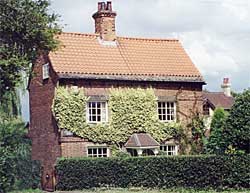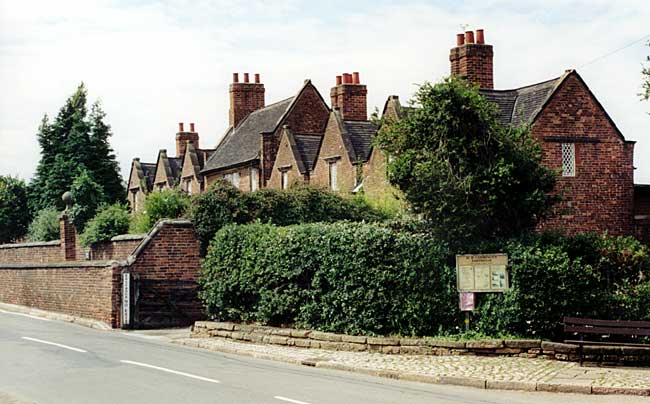Changing conditions

Church Cottage, Cossall (photo: A Nicholson, 2003).
With the advent of the 16th century the appearance of the village began markedly to change. The colliery was expanding as the use of coal extended, and a number of smallholders enclosed their lands within hedges and ditches for the pasture of sheep. At Wollaton this was being done on a larger scale, somewhat to the depopulation of that part, but here the areas affected were too small to entail much (if any) displacement of the population which at the close of the century was about 70. For the muster array in 1539 only eight men were found fit to bear arms.
Like the Willoughbys the Strelleys had been increasing their possessions at Cossall, but in 1535 their great estates were broken up through lack of male heirs. By one heiress-daughter a house in the Marsh passed with properties elsewhere to Thomas Poutrell, and another daughter brought other Cossall lands by marriage to the Paynells. Yet, in 1560, Sir Nicholas Strelley had land here: perhaps he had acquired it by purchase for he was interested in [text missing].
The suppression of the various monasteries having properties in Cossall, wrought a yet greater change. Their possessions were seized by the Crown which long kept some in its own hands and sold off the remainder. When Newstead Priory was dissolved in 1539 it was deriving an income of £6 6s. 8d. from its lands in the Marsh. In the following year the 'Abbey' and its possessions were purchased by Sir John Byron, but if its lands here were included in the sale they must have been resold by 1567 when Queen Elizabeth granted them to Percival Bowes and John Moysier.
In 1549 the ill-fated Sir Michael Stanhope included among his many similar purchases the acre belonging to the church light; in 1585 part of the old Newstead property passed to the Manners family; in 1604 two speculators named Ramsay and Emerson obtained a grant of the Felley Priory portion, and the "lands in the fields" which John Strelley had left for "a priest and two poor men to pray for his soul for 40 years" returned to his descendants.
Elizabethan Cossall
The chapel of St. Catherine at Cossall was served from the mother church in Wollaton, and in 1560 its rector, William Underne (of whose life strange stories are told), was deprived of the living for inveterate gambling and other unedifying habits. About 1574 the adventurous Sir Francis Willoughby purchased additional land for the development of his pits, and in 1583 when he had completed the building of Wollaton Hall he entertained his Cossall tenantry within its walls. The knight's first wife having died he determined to marry again to spite his heir and the lady whom his servant chose, for him in London proved to be a scheming termagent who, upon the knight's death, seized as much of his property as she could, so that his successor had to fight in Chancery for his rights here and elsewhere and his inheritance came to him heavily cumbered. The new pits had been abandoned "though the coal is good and reasonably thick, and the water not unreasonable."
The 17th century dawned at Cossall with lawsuits and squabbles which slowly settled down with the Willoughby's enhancing their interests. In 1602 a schoolmaster was appointed in the person of Nicholas Doubleday, who was also parish clerk, and would teach in the church or its porch, and at the accession of James I, Robert Aldridge, vicar of St. Mary's, Nottingham, was also holding the livings of Wollaton, Cossall and Sneinton; he was one of the few pluralist clergy in the county at the time. Cossall would not much enhance his income for in 1650 the "preaching minister" of Wollaton and this parish received a stipend of only £10 a year.
In 1676 George Willoughby, nephew of the lord of Wollaton, had his seat at Cossall Wood Hall; an ancient building of whose moat traces still remain. The village had than 40 adult inhabitants and an inn. The parson reported that only two persons were "known or suspected to be recusants," but he must have turned an indulgent eye upon the Romanist Willoughby family and the County Records disclose the presence of others of his faith.

The Willoughby Almshouses date from 1685, Cossall (photo: A Nicholson, 2003).
In 1685 this George founded and endowed a hospital here for four poor men and four women each of whom was to receive £5 yearly with grey material at 3s. a yard for attire and 5s. a. year for coal. No man under 60 or woman under 55 was eligible for admission. All were to live singly, marriage entailed expulsion as also did refusal to wear the distinctive hospital dress. The charity still functions, but with increased allowances.
Curious records
The Cossall Willoughbys refused to acknowledge William III, as king, and in 1683 they were deprived of their horses and arms though they were presently allowed to have one gun for the safety of their home. In 1715 Robert Willoughby declined to take the oaths to King George and his estates here and at Attenborough were valued for sequestration, a fate averted by the collapse of the Jacobite rebellion.
Among the records preserved in the parish chest are the accounts of the churchwardens and overseers of the early Georgian era some of the items offer quaint reading. For "ringing a verry fine peal" on the anniversary of Gunpowder Plot the charge was 1s. In 1731 new stocks were supplied at a cost of 7s. 6d. In 1736 the officers charged 1s. 6d."for going to Beeston statutes" and 2s. was "paid for a shift for Caroline Chambers." "Searching the Town and going to Ilkeston with hue and cry" in 1740 cost 1s.; and in 1744 8s. was spent upon "a Press warrant and officers attending the Justices," with a further 1s.; (probably for ale); "when we search for men fitt for the king's service." On another occasion 6d. was charged "for sitting up with Betty Grace.
The timehonoured method of transporting coal by packhorse and wagon was largely superseded when the canal was made in 1792, but residents in the Marsh received an unpleasant shock when the embankment gave way in 1823 and torrents of water deluged their homes.
Meanwhile notable events had occurred. The 300 or more inhabitants had been disturbed by an irruption of Luddites bent on smashing hosieryframes in 1811, and in 1815 three Cossall men had perished nobly at Waterloo. A sculptured tomb erected in the churchyard in 1877 commemorates the fame of Shaw, the Lifeguardsman, Richard Whaplington and Thomas Wheatley. The heroic deeds of Shaw have often been told and are commemorated by Scott:
Nor 'mongst her humbler sons shall Shaw a'er die,
Immortal deeds defy mortalty
At that time the old church was in very decayed condition. It had been reroofed in 1718 and contained a 17th century pulpit with a piscina in the south aisle which had served as the chantry chapel. There were two bells, one of which was said to have been the Hall dinnerbell, a few ancient monuments, an old font and some heraldic glass, and divine service was performed but once a fortnight. In 1842 the church was rebuilt, and of the old structure only the tower and its diminutive spire remain, but the font and the glass were spared. The population then was declining and reached its modern nadir with 244 in 1831, but at the next census it was 829, and now numbers about a thousand, a total likely to be increased by the discovery in 1943 of a 4ft. seam of good household coal.
